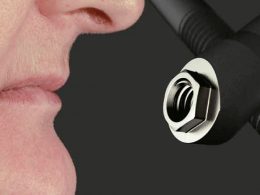Table of Contents
Since the first description in 1998, the rehabilitation using the zygomatic implants suffered technical modifications over the years, however, the indications remained the same: repair the aesthetic and functional aspect of mutilated patients or in cases of severely resorbed maxillae, which makes impossible to install the conventional dental implants.
The great advantage of this type of rehabilitation is not only to minimize postoperative morbidity caused by reconstructive surgeries (multiple bone grafts), but also to eliminate hospitalization, high cost and risk of complications. Over the years, it was proposed a modification of technique using just four zygomatic implants (Quad Zygoma), mainly when the pre-maxilla presents severely resorbed.
But, after more than 20 years of experience with these implants, what can our patients expect?, what do the statistics show?
A Probability of Success Close to 100% of Cases!
The revision of one randomized clinical trial, 16 prospective studies and 51 retrospective analyses made during the last years in many countries like Spain, United States, Brazil, China, Germany, Italy, Portugal, Belgium, Colombia, South Africa, United Kingdom, Japan, Norway and Switzerland; on 2,161 patients and 4,556 zygomatic implants placed, revealed in total the failure of only 103 implants. In statistics, these figures indicate a success rate of 97.74%.
If we consider that many of these implants were performed in cancer patients, undergoing maxillary resection procedures, with their bones weakened by radiation therapy and exposed to recurrence of tumor masses; we can conclude that, under normal conditions and under the manipulation of a truly experienced Maxillofacial Surgeon, the success rate of these implants is almost 100%.
Why Could Such an Implant Fail?
Although the rehabilitation using zygomatic implants is a consolidated therapeutic option, and although it is a predictable technique, it does not lack in possible complications, therefore; it should be reserved only to professionals with vast surgical experience, as it requires a long learning curve and prior experience with conventional implants.
Generally, the risks and complications from zygomatic fixation have their origin in the inexperience of the surgeon and marked anatomical and histological variability of the patient. Among them we can find:
- Sinusitis and Oroantral Communication The zygomatic implant placement may result in a foreign body reaction, in the form of inflammation of the sinus membrane, may be triggered by a treated implant surface against a finished one, an oroantral communication produced by perforation of the Schneiderian membrane, and a lack of osseointegration of the coronal part of the implant.
- Non-Osseointegrated Implants Causes related to the lack of osseointegration include overheating, contamination and trauma during the surgery, insufficient bone quantity or quality, lack of primary stability and incorrectly indicated immediate loading.
- Local Infections Local infections or mucositis are directly related to the appearance of sinusitis, favoured by the lack of osseointegration, lack of contact between the implant and the bone crest, superficial infection and lack of cicatrization of the soft tissues. Prosthodontic rehabilitation also plays a relevant role.
- Oroantral Fistula Lack of osseointegration at the marginal area of the implant at its palatal aspect, along with functional forces, may increase the risk of oroantral communication, development of sinusitis and oroantral fistula.
- Paresthesia Paresthesia from affection of infraorbitary and zygomaticofacial nerves have been reported, however, in the majority of reviewed cases, paresthesia remits between 3 and 8 weeks postintervention.
- Bruising This complication ranks fourth in terms of frequency, with 3.9%. The incidence is probably higher, due to the fact that many authors do not mention this as a complication, possibly due to its less alarming clinical manifestations, being self-limited, and associated with the postoperative period.
- Labial Laceration Possibly one of the most common complications, and as mentioned in the case before, it is also underdocumented.
However, the complications mentioned are so rare, that many studies claim not to find them in any of their samples.
Why Is 3D Cone Beam Scanner Use so Important to Prevent Failures?
The presurgical anatomic assessment to define the desired zygomatic implant projections cannot be performed using panoramic radiograph or computed tomography (CT) 2-dimensional (2D) images, but requires a 3-dimensional (3D) view of the maxillary arch.
In theory, zygomatic implant insertion planning can be accomplished with CT, but will undoubtedly be more accurate with Cone Beam Computed Tomography (CBCT) study which is then analyzed with interactive surgical planning software. The professional challenge is to perform accurate pre-surgical diagnostics to clearly define the entry point, trajectory direction and exit point of the zygomatic implant, and then accurately reproduce them during surgery.
Zygomatic implantology is quite different from conventional implantology, since due to the great length of its implants, it is very susceptible to small errors in angular deviation, which could significantly alter the trajectory and positions of the apex, with the risk of possible serious complications for the patient.
Furthermore, the surgical guides that have been used for the placement of zygomatic implants manufactured in the same way as those of standard length implants, do not provide any trans-sinus control during the execution of the osteotomy. Thus, surgeons usually prefer to prepare the surgical beds freehand, to facilitate visual control of the drilling process; but always having at hand a three-dimensional view of the patient’s maxillofacial complex.
How to Choose the Right Surgeon
Within Maxillofacial Surgery, there are a number of subfields. For instance, some surgeons specialize in providing just conventional implants, while other specialize in removing teeth, cysts and tumors; others in treat facial trauma, others in oncological and reconstructive surgery, others in orthognathic surgery, and others in zygomatic implants. Use your intuition, and especially your knowledge of the procedure you need, to choose the most suitable Maxillofacial Surgeon.
Furthermore, during the selection process it is very important that:
1- Ensure Your Surgeon Is Qualified
Maxillofacial Surgeons should have four level certification, meaning they have met the requirements outlined by their profession and can be trusted to perform Maxillofacial Surgery. Remember that an Oral Surgeon is not the same as a Maxillofacial Surgeon. They should also meet local licensing or certification requirements, which vary from place to place. For instance, your local state or province might have certain rules that the surgeon must conform to in order to practice.
2- Look for a Maxillofacial Surgeon Who Has Membership in Professional Societies
When Maxillofacial Surgeons are members of professional societies, they demonstrate that are committed to staying apprised of all the latest developments in their field, and deserve special consideration when you make your selection. Whenever possible, choose a surgeon who is a member of a society such as the American Association of Oral and Maxillofacial Surgeons or a similar group at the local or national level.
3- Select a Maxillofacial Surgeon with Experience
Generally, the longer a Maxillofacial Surgeon has been practicing, the more secure you should feel in their abilities. Select a Maxillofacial Surgeon who has been in practice for a number of years and is well-established in his/her country.
4- Rate His/Her Career and Leadership in the Specialty
As a general rule, the most qualified and reliable Maxillofacial Surgeons are those who excel and exercise leadership in the profession; through teaching, research and union leadership. It is almost impossible for a postgraduate director, head of service or a high-up from a recognized scientific society; demonstrate academic or professional deficiencies in the performance of their work. Holding leadership positions is very difficult in this specialty, they always require the recognition and consensus of other colleagues and are the maximum guarantee of experience and capacity.
“In the Hands of an Experienced Maxillofacial Surgeon, Zygomatic Implants Have a Probability of Success Close to 100% of the Cases”.
DENTAL TIP
Why Do People Go for Zygomatic Implants in Venezuela?
Because it is one of the most expensive and delicate dental treatments; often inaccessible to the vast majority of people residing in North America, Europe and the Caribbean Islands.
DENTAL VIP offers the possibility of being treated by the best team of Maxillofacial Surgeons in Venezuela, under excellent hospital conditions and based on the most efficient and safe surgical protocols on the planet; without the price of the procedure representing an obstacle to it.
Doing dental tourism to our country, with the lowest operating costs in Latin America, is often the only real opportunity to face complex, extensive or highly specialized dental treatments.
Contact us today, clear doubts and start planning a trip that, although it is not for pleasure; will provide you with satisfaction, well-being and quality of life for lifetime.












